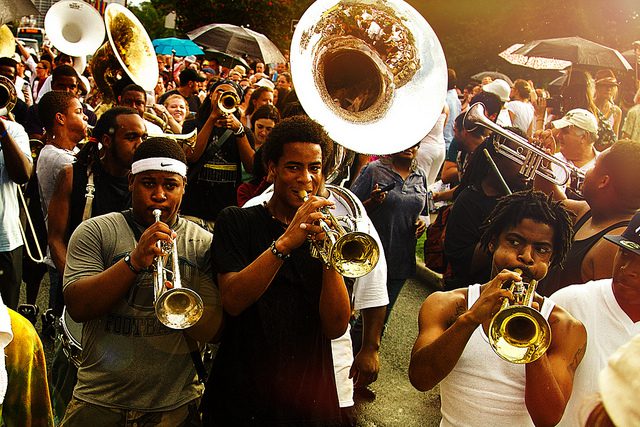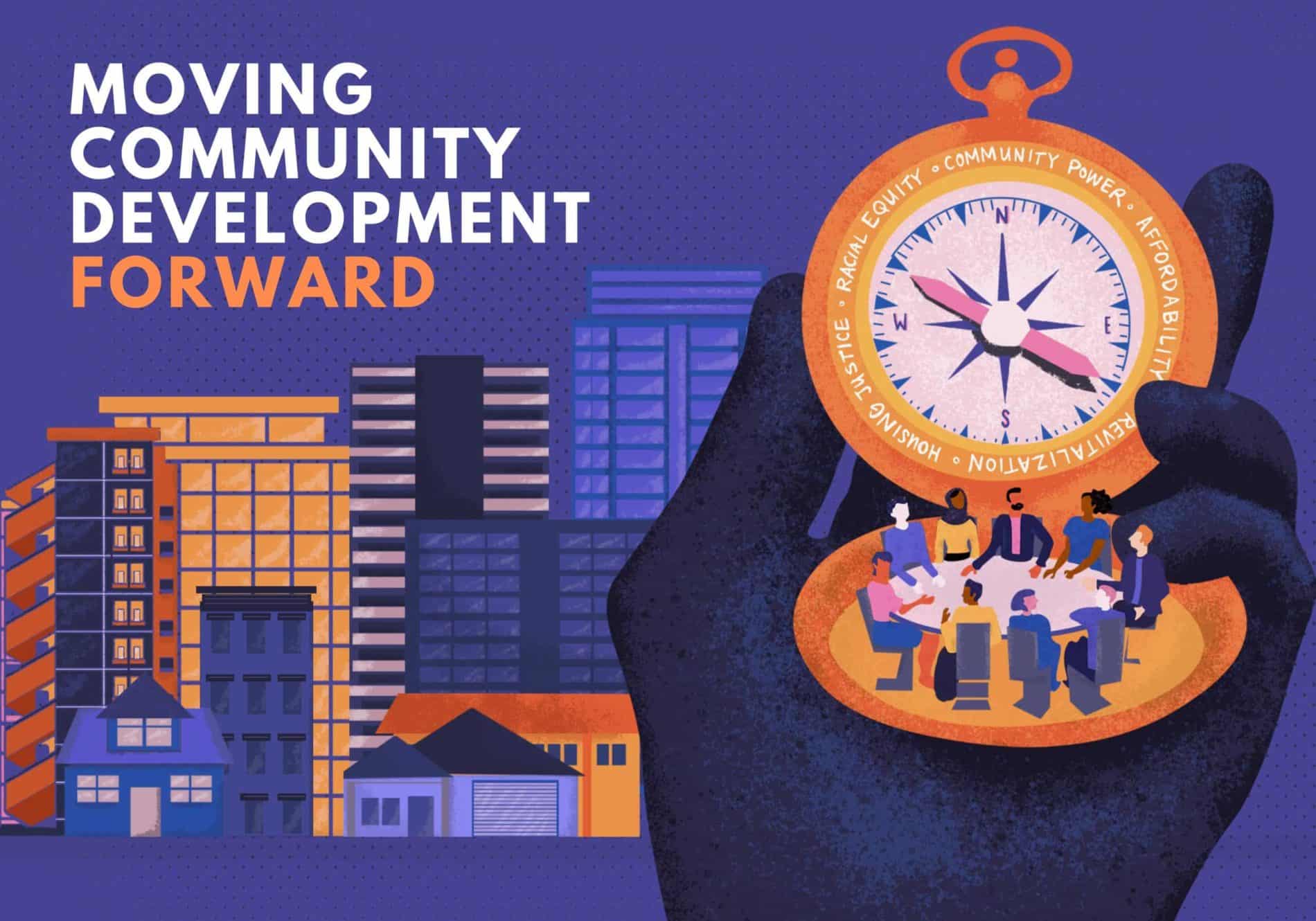
‘Uncle Lional’s JazzFuneral.’ Photo by Darrell Miller via flickr, CC BY-NC 2.
Airbnb may be great for tourists to New Orleans and hosts who are actually taking people into their own homes, but organizers in this video say that in most places, many listings are actually commercial operators with multiple properties who are emptying out whole neighborhoods, making it even harder for the culture bearers who make New Orleans attractive in the first place, to live there.
It is possible to have transit-oriented development (TOD) without turning a neighborhood white. That’s the most solid takeaway from a new study that compared several neighborhoods in Oakland, California, with Fruitvale Station, the location of Fruitvale Village—one of the first equitable TOD developments, which includes some affordable housing, social services, retail, and public space. While incomes have risen dramatically around Fruitvale, the neighborhood’s historically high Latino population has remained unchanged—and we share the hope that this means that displacement was prevented. While the study carefully selected neighborhoods that were comparable, there are still many questions the study wasn’t able to clearly answer, such as were previous residents able to stay, or were lower income Latinos replaced by higher income Latinos? Did existing residents’ income rise, or is the income rise attributable to new higher income residents living alongside original residents? How did the income spread change? And how much of a role did the Fruitvale Village play in these outcomes, and which parts of the project created the effect? Good questions to have.
#OpportunityStartsatHome. We’ve seen our share of branding attempts to bring affordable housing awareness to the masses—Make Room, Home Matters, and more. While they have all been inspiring, and contributed to a greater sense of unity of purpose within the field, none have quite cracked the elusive nut of viral narrative shift. Opportunity Starts at Home, a new campaign launched by the National Low Income Housing Coalition and funded by the new Funders for Housing and Opportunity collaborative, just might go the distance though. Its partner list is extremely impressive, and importantly includes non-housing heavy hitters like the National Education Association. Pair that with rising housing costs becoming a concern for more people and the fact that NLIHC’s Out of Reach housing affordability maps have been circulating social media virally for years, and we’re feeling hopeful.
Efforts to get more people of color riding their bikes safely and reduce inequity in Chicago’s bike sharing system evolved into one man’s founding of a nonprofit that will—among other things—create a “bike library” that will allow low- to moderate-income residents to borrow bicycles for up to three months. Equiticity’s mission is to tackle racial equity and increase mobility and racial justice in biking, and includes promoting a discrimination-free environment for people of color to ride bicycles. The library applies common-sense knowledge in its design of the program, which gives people time beyond traditional bike share’s limited allotments to fit bicycling into their lifestyle.
In last week’s Shelter Shorts, we took note of the recent report on gentrification’s effect on health. An article in The New York Times brought up the possibility of gentrification—one aspect of which is people moving into neighborhoods but remaining unfamiliar with their neighbors—playing a role in the police shooting death of a mentally ill man. 911 calls were placed as the man ran through the Brooklyn neighborhood making threatening gestures to people, but longtime members of the community later said they were familiar with his behavior, and the encounter could have been handled in a non-lethal manner.
By their fruits shall ye know them? We’ve been impressed with the YIMBYs’ willingness to address entitled NIMBY sentiment head on—but their definition of who falls into that is extremely broad, and sometimes quite troubling, as at a recent rally where they shouted down housing advocates of color. Not a good look guys—or a careful analysis of who is the problem either.
An opinion column in The Week reopened a longstanding conversation about equity in metropolitan regions by reminding us that fragmented regions essentially consist of freeloading suburbs hoarding their tax dollars for more-or-less explicitly racist reasons while relying on their core cities for everything from jobs to housing for their own low-wage workers. Correspondent Ryan Cooper echoed David Rusk’s Inside Game/Outside Game when he argued that annexation was the solution. Sadly, while he makes a good case, a startling slip-up in his historical recounting in which he asserts that “as black people moved out of the South and into cities elsewhere in the country in the mid-20th century, they generally congregated in the inner cities” (emphasis added), instead of acknowledging the raft of policies, regulations, and violence that forced that congregation, really detracted from an otherwise strong piece.
What it takes to help families transition when the public housing complex in which they lived is demolished or redeveloped is no mystery. It isn’t easy, either, but many places have been putting in the work to try to do it better. See, for example, Harmony Oaks in New Orleans, or the Hope SF project. But a recent ProPublica article shows that in smaller places that get less attention, like Cairo, Illinois, residents still struggle to get timely information and relocation help.
For those paying attention to the country’s affordability crisis and subsequent displacement, the fact that it extends to local small businesses and commercial space is not a secret. But this piece from Boston’s WBUR highlights an interesting ripple of gentrification in the city: rent prices for commercial spaces are not necessarily lower in non- (or pre-) gentrified neighborhoods, and in some cases, are just as high as spaces in neighborhoods where gentrification is underway. For capital-poor, small business owners seeking space, this means that nowhere is truly affordable, and operating in neighborhoods in or close to home is growing more impossible by the year. Nonprofit assistance can’t address the full scope of need, but subsidy from local government (signaling the same kind of commitment it has to developers) would be a start.
There’s no doubt about it—we’re in the middle of another housing crisis. A newly released nationwide database called Eviction Lab is helping us get a clearer look at this critical situation. Led by Evicted author Matthew Desmond and his team at Princeton University, the project—the first-ever dataset of evictions in America—examines more than 80 million eviction records dating back to 2000. Daily, more than 6,300 Americans are evicted each day, which nearly four evictions filed every minute. We’re still combing through the data. There’s lots to review here.
As we’ve noted here, the past several months have been rough for New York City’s public housing authority. After a spate of stories about falsified lead certification records, widespread heat outages, and mold issues, the authority’s chair, Shola Olatoye, has resigned. Shelterforce was an early fan of Olatoye and her vision (SFLINK) for public housing, and are sorry this story’s chapter in the nation’s largest public housing authority has ended this way. Over her four-year tenure, Olatoye began such programs as NextGen NYCHA and the rental assistance demonstration initiative called PACT.
As the nation grappled with the 50th anniversary of the assassination of Dr. Martin Luther King Jr., activists across the country were working on continuing the work he was engaged in at the time of his death. A revived Poor People’s Campaign, which has been organizing locally all over the country for several months, released its demands this week, in a document they are calling a “moral agenda.” “The Democrats talk about the middle class. The Republicans talk about the military,” PPC leader Rev. William Barber, who has been holding “Moral Monday” events in North Carolina for many years, told the Associated Press in an interview on Monday. “No one’s talking about the poor.”
Simple yet elusive. Two articles this past week discuss a research paper that proposes the U.S. should be turning its car around and headed back in the direction of social housing. The difference in the authors’ version is it would be financed by municipalities (and built on city-owned land), using low-interest bonds and the same federal subsidies that provide low-income housing tax credits to for-profit developers. Unlike existing public housing, units would be open to a wider range of income earners, from low to middle, hopefully decreasing rent burden across the board and easing the pressure that is causing displacement due to lack of supply.
Closing costs are one of many barriers to homeownership, but a recent change announced by Fannie Mae is helping to ease that financial burden a bit. Fannie Mae will now allow lenders to “gift” 2 percent of a borrower’s closing costs, according to Housing Wire. The gifted funds are not subject to repayment.
Could cutting down emergency room visits be as simple as delivering meals to those who are sick? Maybe. Low-income seniors and disabled people who received home-delivered meals had fewer ER visits than those who did not receive meals, according to a new Health Affairs study. “We do know that people, when they face food insecurity, often make a lot of trade-offs: Do I pay for my food? Do I pay for my medicine? Not knowing where your next meal is coming from is stressful. It may be difficult to manage your chronic condition when you’re worrying about that,” says a professor who led the study.
A recent federal court ruling about the government’s educational obligations could cause a ripple effect across the U.S. A court ruled that the government must meet the mental health and wellness needs of Native American students attending its schools. “The court’s ruling recognizes the impact complex trauma and adverse childhood experiences have on a child’s ability to learn, to the extent that such children may be disabled and require special education programs,” according to the Chronicle for Social Change. This is big. We’re curious to see where this goes.
There’s no question that college costs have risen dramatically through the years, and that something needs to be done before the situation gets completely out of hand (though it arguably has already). While the “college-is-too-expensive” conversation tends to focus mostly on student debt, another issue is emerging that requires immediate attention. College students are skipping meals because they can’t afford to eat. Researchers surveyed 66 colleges and found that 36 percent of students did not get enough to eat, and a similar number didn’t have a safe place to live. The report also found that 1 in 10 community college students went a whole day without eating in the past month. How can these students absorb any of the information they are taught without brainpower from food? This is an incredibly sad piece that should be required reading because this issue isn’t going away anytime soon. In fact, it’s likely to get worse.
Not going anywhere: A Portland program that made it so landlords had to pay the moving costs of renters who were either evicted without cause or forced to move due to a large rent increase has been made permanent. Supporters of the program say it has helped renters avoid hikes in rents and expensive moves. Bravo, Portland.




Comments